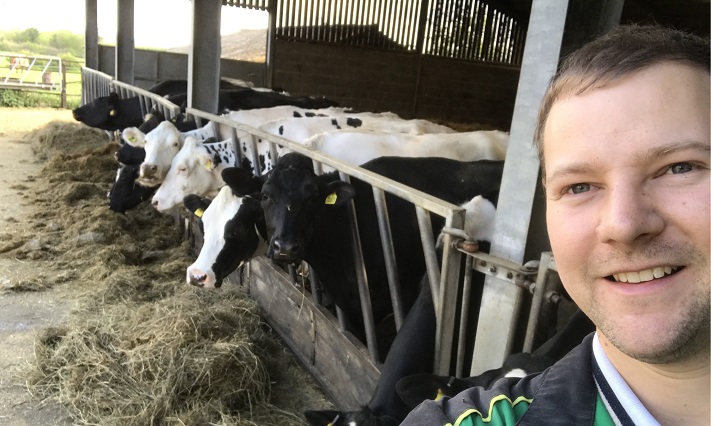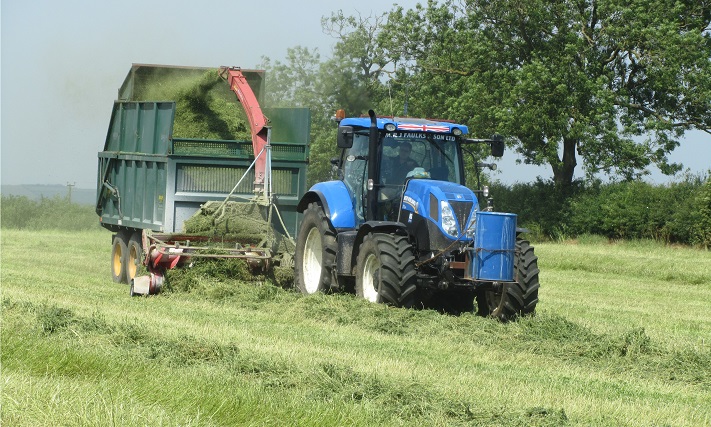Lucerne offers host of benefits
Lucerne is the answer to blackgrass and provides valuable feed for dairy cows
Mixed arable and dairy farmer Ben Stroud first drilled lucerne in the summer of 2014, into two fields of an 11ha (26 acre) field that suffered from terrible blackgrass.
Weed control in the first autumn and regular cutting for silage the following spring and summer, soon sorted out the problem. After cutting this year, this field will make way for a new crop of winter wheat.
 Ben with the cows behind eating lucerne hay
Ben with the cows behind eating lucerne hay
“We drilled the variety Daisy in August after winter wheat into a very good seedbed,” explains Ben. “While lucerne is a very deep rooter – it hates any compaction and we take our time to give it the best start possible.”
Soils in the fields at The Grange are primarily heavy clay. Ben feels sub-soiling the field is essential – something he failed to do the first time he grew it. A shallow seedbed is then prepared in the cereal stubble with discs, before being consolidated with press and Cambridge rolls.
The seed is broadcast onto the surface of the soil using a drill that is lifted almost out of work, literally dropping the seed onto the soil. The field is then rolled again.
“We spray with fluazifop-P-butyl against cereal volunteers and 2,4-DB to take out any broad-leaved weeds in the autumn,” comments Ben.
“Then we treat it with some propyzamide in January, which is still good against blackgrass. The lucerne is dormant over this period and remains unaffected. But the terrible mat of blackgrass has gone. When we take the first cut – we can see the base of the sward is very clean indeed.
“Establishment costs are slightly higher than for grass, but spreading these over four years growth makes them more sustainable.”
The 224ha (550 acre) farm grows 142ha (350 acres) of cereals including wheat, barley and oilseed rape. It also supports a herd of 170 cows and followers on 82ha (200 acres) of grassland, including 16ha (40 acres) of the red clover Oliver Seeds silage mixture Sabre Hi Pro, which produces high quality, high protein forage.
“We are reducing bought-in feed costs by growing more protein crops like the lucerne and red clover and feeding home-grown rolled barley. Our milk goes locally to Long Clawson Dairy for Stilton cheese, so maintaining butterfat and protein content level all year round, is important. The cows are averaging 9,000 litres of milk a year, at 4.2% butterfat and 3.4% protein.
“The lucerne also provides fibre to the total mixed ration which is good for rumen health and allows us to feed more starch. We used to feed straw to increase fibre in the ration, which has no nutritional value, but we don’t any more.
“We are feeding up to 9kg of lucerne fresh-weight, from bales, which are 50% dry matter. And the cows love it.
“Yield from the lucerne fields has been very consistent. Last season the first year lucerne yielded the same as the third year field at 33t/ha, which gave us approximately 20 round bales per acre from four cuts.
“When the cows are out grazing for seven months of the year it can be a challenge to keep the milk solids up in late summer. But the consistency of the lucerne in the ration helps maintain milk quality.”
Cutting for silage
The leguminous lucerne starts growing in March and receives no other treatment, not even fertiliser, until first cut in mid May.
 Picking up second cut lucerne
Picking up second cut lucerne
The field is cut with a mower conditioner early in the morning leaving a 10cm (4 inch) stubble, to protect the all important growing point of the lucerne plants, and also to allow the young emerging leaflets to flourish.
The crop is left to wilt for 24 hours before being rowed up – again early in the morning to prevent losses due to leaf shatter, as the crop is still moist.
In the first year the lucerne yielded 150 tonnes of forage from the first two cuts and was placed into clamps and topped up with wholecrop silage – making a well-balanced mix for the cows. But the past two years, Ben has made round bales with it, wrapped in plastic, which gives more flexibility for feeding. The later cuts are less fibrous and have more protein than the earlier cuts.
After each of the two first cuts, 30 to 40t/ha of slurry is applied to give the crop a good dose of phosphate and potash, but only if soils conditions allow. Ben once made the mistake of going in with the tanker when the soil was too wet and the wheelings were visible for the rest of the season.
Good for soil health
Ben feels that low input lucerne has much to offer arable farmers looking for a rotational crop to improve soil health.
“It is amazing to see the roots going down a metre or more into the soil, increasing the vertical channels in the structure and improving drainage.
“There are many more worms under the lucerne and even in the heavier spots, the soil seems much more friable. And the following winter wheat will also benefit from the nitrogen-fixing that has taken place over the previous four years.
“Being a mixed farm we are lucky that we have cows to eat the lucerne – but perhaps on pure arable farms there would be opportunities to market high quality winter forage to others. After the wet winter and late spring, silage stocks are pretty low on most livestock farms – so I am sure there must be demand for high quality forage across the country.”
Top tips for growing good lucerne
Ben has been supported through his first years growing lucerne by Rod Bonshor, general manager of Oliver Seeds.
Here are Rod’s top tips for growing a good crop:
1. Ensure soil type and situation is suitable for lucerne - it prefers lighter, free draining soils
2. It is best to sow into a clean, firm, level seedbed
3. Choose a variety with high winter dormancy rating such as Daisy - this helps with winter weed control
4. Use pre-inoculated seed for ease of handling and sowing
5. Inspect the young crop regularly as it will be very attractive to slugs, pigeons and other pests due to its high protein content
This article first appeared in the July issue of Farmers Guide magazine.
